Abstract
The concept of Responsible Research and Innovation (RRI) became more and more visible in the last few years and is one of the new pillars in the European Commission policy, in particular within the European Commission’s Science in Society programme, framed within the EU Horizon 2020 initiative. Taking into consideration the presence of this concept into the FP7 Programme priorities, a big number of European projects have been approved and financed by EU, in order to bring closer the research and innovation results to the people. One of those projects is the FP 7 ENGAGE Project (“Equipping the Next Generation for Active Engagement in Science Equipping the Next Generation”, www.engagingscience.eu). The partnership of the project proposed to come with interesting continuous development programmes for teachers, organized through face-to-face workshops or on-line courses, where different interactive-participatory teaching strategies are presented and many examples of applying these strategies are discussed. These examples start from identifying a problematic situation (dilemma) that students may face in their real life and they need to find rational solutions, by using their scientific and socio-moral knowledge. The paper presents our findings based on the analysis of the Romanian teachers’ feedback after they finished the 1st edition of the on-line course “
Keywords: Interactive-participative teaching strategieson-line coursesinvestigationdilemma lessonsENGAGE project
1. Introduction
We are living in a world full of research and technology. In each day we are surrounded by new and
tiny but very powerful devices that use new materials and sophisticated technology. A big number of
companies invest a lot in area of nanomaterials or new technologies, based on the new research and
discoveries, together with very innovative results. We are forced to keep up the line with the
technology development and sometimes it is really difficult to make it. This is because a lot of
researchers put their efforts to lead us forward, to a new world of science and technology. But in this
context, using new materials with unknown properties or facing a huge number of the challenges and
risks during the development of new technologies, the overall risk of research and innovation to the
society became a topic more and more discussed. People are willing now to discuss and understand the
science policy and to transform this policy in order to have more benefits from the research area. This
involves a paradigm change from the scientific freedom to expectation of socially-beneficial impact,
precisely a change from the Science in Society to the Science for Society. This means that people want
not only to read about new discoveries in science or technology, but also to hear what benefits are
brought by those innovations for their lives.
In this respect, it was proposed the concept of
still insufficiently clarified even in the scientific literature, although it is more commonly used in the
European Union policies and programmes related to Science and beyond.
In fact, at the moment, RRI underpins several European projects and it represents the current image
of the connection between Science and Society in the European Commission vision (European
Commission Decision, 2015).
The mean of the RRI concept is any action of research and innovation which must be developed by
a researcher in the context of assuming of the social and individual responsibilities. In this respect,
research and innovation must meet a series of social, moral and ethical principles, has to be benefic for
the society as a whole and for each individual. In addition, RRI must take into consideration the ratio of
benefits and risks, to contribute to human progress and to be subordinated to positive purposes.
Since RRI concept is one of the priorities of the European Commission policy, being emphasized in
the frame of
financed by EU to promote the research and innovation dimensions to the general public.
2. The ENGAGE Project
The ENGAGE Project (Equipping the Next Generation for Active Engagement in Science Equipping
to emphasize the RRI dimensions and introduce them into the Science lessons. The partnership of the
project is formed by 14 institutions from 13 countries that are trying to make Science lessons more
attractive, by promoting different interactive - participatory teaching strategies, based on involvement and
investigation of the reality, identifying and testing alternative solutions, which allows students to think
and apply their knowledge and consequently to make responsible decisions. In this context, the
partnership proposed a 3 stage model for the teachers’ development, to represent how teachers typically
absorb an approach like RRI-teaching (Dwyer et al, 1991) adapted by Rogers and Twidle in 2012. According to this model, the teachers has to pass three steps of personal development (Fig. 1). The 1stStep (
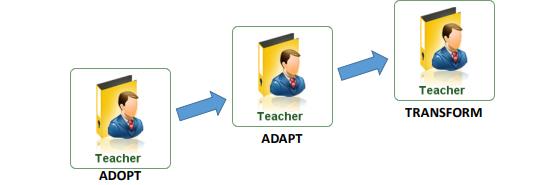
In order to help teachers to understand easier the RRI philosophy and how the materials proposed by
ENGAGE partnership can help them to introduce RRI dimensions in their regular Science lessons, in
the frame of the project each partner had to organize face to face workshops and on-line courses in a
with Science teachers (Chemistry, Physics and Biology) from different counties and promoted also the
on-line course entitled "Methods of promoting RRI dimensions in Science Education" to the level of the
Science teachers’ community. The first edition of the on-line course was organized on the
during Nobember-December 2015.
3. Results and Discussions
The Romanian on-line course was carried out for seven weeks and comprised two stages (
to teach the skills related to understanding and learning RRI, and also implementing ENGAGE
materials in the classroom. A number of 58 participants were registered (in-service science teachers and
university students involved in chemistry/chemical engineering bachelor study programme) and started
the course. The distribution of the target group is illustrated in Figure

The experience of the pre/in-service teachers related to participation to on-line courses was
different, function of their age and teaching experience (Fig. 3).
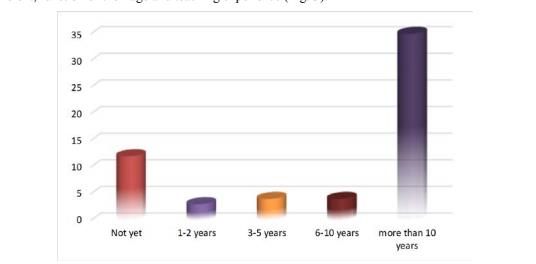
Figure
teaching Sciences, in order to ensure the possibility of creating an active community on
topics presented during the on-line course and discuss about the possibilities to implement in the
Science lessons the ENGAGE materials. As it was expected, rich discussions were developed weekly
on the on-line course, in relations with the topics and established assignments.
During the on-line course the VUT team had three tutors who kept contact with participants and gave
them details of how to solve the tasks. A total number of 44 participants achieved the tasks and finished
the Romanian on-line course, their distribution concerning the teaching area is illustrated in Fig.
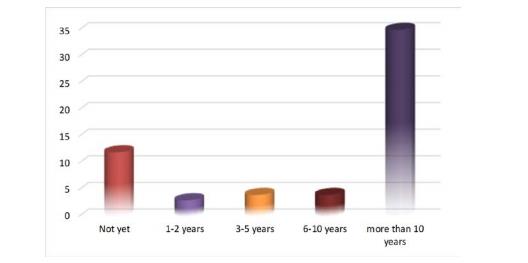
In order to make some connections between the
“
experience about teaching Science through interactive teaching methods like problem-based learning or
IBSE. The obtained data, illustrated in Fig.
practice for Romanian teachers, being used by them only “
they frequently use those methodologies in their regular Science lessons. This is one of the reasons why
such kind of on-line courses focused on presenting new and modern teaching methods and give
examples on how to use them during the regular classes of Sciences have to be organized much often in
order to convince the teachers to start to use these methods as regular teaching practice.
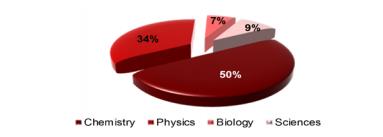
From the answers given by the teachers, it can be noted that they use frequently in their Science
lessons teaching methods like: discussion, conversation, problem solving and scientific argumentation.
If we take into consideration that one of the most interactive teaching strategy is dilemma, because it
creates the premises for students to make a difficult choice between two or more alternative, equally
controversial, one of the questions introduced in the questionnaires addressed to the teachers was
related to their previous experience to use this teaching strategy in teaching different scientific topics.
Regarding the use of socio-scientific dilemma in teaching Science, most of the teachers’ answers were
"
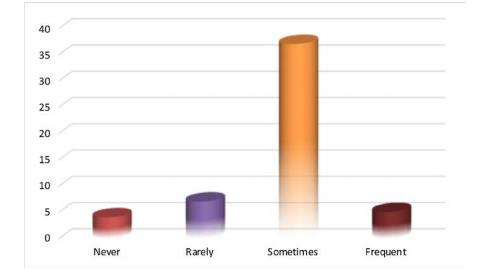
In the frame of Science Education, dilemma refers to the socio-scientific controversies relating to
the applications and implications of Science (Ratcliffe, 1997). It also includes a productive learning
context and facilitates a better understanding of scientific topics, developing the students’ skills and
attitudes. It also strengthens the decision making and problem solving (Koballa, & Tippins, 2000).
Trying to stress the benefits of using the interactive teaching strategies in Science lessons, it was
introduced in the questionnaire addressed to the teachers the question “
objectives you achieved in this course?”, with multiple choice answer:
a) Motivating students to learn science in a fun way;
b) Development of students’ investigative skills;
c) Increasing students’ interest for scientific topics;
d) Assessing the way that modern science can engage students to think and talk;
e) Using the 5E model in Science lessons to develop RRI investigation/skills.
Teachers have the possibility to weigh the level of achieving of those objectives by using a 4-steps
Likert scale (0 - indifferent, 1- low, 2 - medium, 3 - high). Their answers are illustrated in Figure
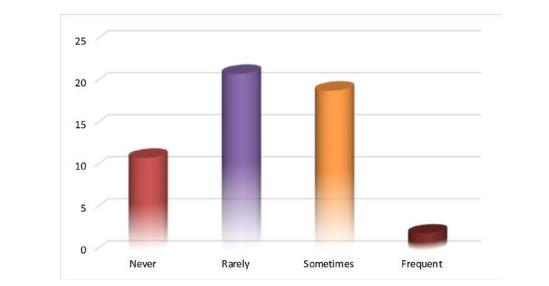
(a) Motivating students to learn science; (b) Development of students’ investigative skills; (c) Increasing students’ interest for scientific topics; (d) Assessing the way that modern science can engage students to think and talk
Starting from the idea that the “5E Model” (Bybee et al, 2006) (Fig. 8) is a 5-steps teaching scenario
in which the teacher creates a stimulating learning environment focused on investigation, research,
experimentation, discovery, that places the student in the position of a responsible researcher, it can be
appreciated that such an approach facilitates the relevant, sustainable and high quality learning,
objectified in the formation / development of solid expertise needed for an optimal socio-professional
insertion of each individual.
In fact, the use of 5E Instructional model of teaching involves the development of responsible
research and innovation dimensions in Science lessons. Thus, it can be said that the “5E model” ensure
the implementation of RRI in teaching Science.
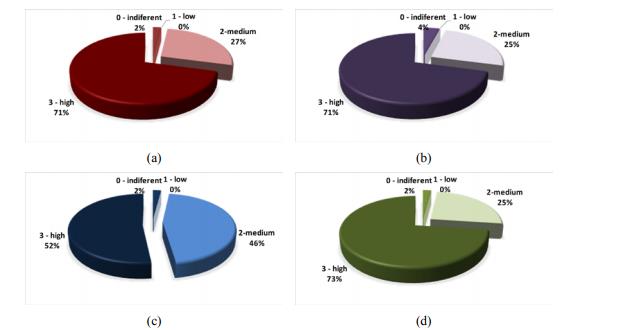
Trying to see the teachers’ feedback related to the level of understanding on how to use this model
and how it is correlated with the development of RRI investigation/skills, one of the questions
introduced in the questionnaire was: “After this course, do you think that you can organize alone a
Science lesson by applying 5E Model to develop the RRI dimensions?”. The teachers’ answers were
again framed in a 4-steps Likert scale (0 - indifferent, 1- low, 2 - medium, 3 - high) and are illustrated
in Fig.
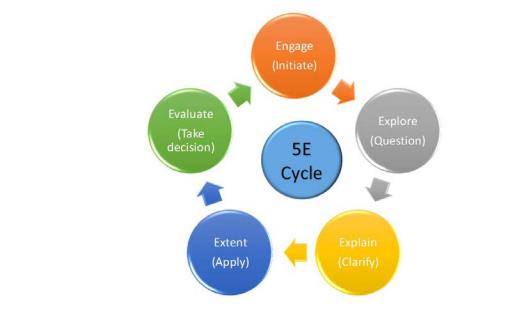
A short analysis of the teachers’ answers show that a big part of the teachers realized the relation
between responsible research and innovation and the 5E model in Science teaching and understood that
the “5E model” can be a good teaching strategy for increasing students’ motivation in learning Science.
At the same time, the teachers appreciate that they can use the “5E model” during their regular lessons
after participating to the on-line course "Methods of promoting RRI dimensions in Science Education".
4. Conclusions
Our investigative approach was based on the replies of a representative sample of Sciences teachers from Dambovita county who were involved in the 1st edition of the on-line course
The data presented in the present paper demonstrates that the involved teachers appreciated the course content, the ways of presenting the selected topics and most of all the examples of dilemma lessons uploaded on the ENGAGE website and translated in Romanian language. All participants appreciated that they have learned a lot, even some of them were very experienced teachers, who were involved in a big number of CPD programs organized in the frame of national/ international projects related to new teaching strategies and tools for increase the young generation interest for Science and Technology.
It was concluded by the teachers that ENGAGE project proposes an interesting way to show students that science and contemporary technology is often based on uncertain evidence and argumentation and their point of view is important. The main conclusion of the target group was that ENGAGE materials are designed in a creative way that make students talk and think, involving them in moral, ethical and social reasoning, based on the analysis of benefits and risks (Petrescu, Gorghiu & Dumitrescu, 2015).
Acknowledgements
This work was funded through the Seventh Framework Programme Project “ENGAGE - Equipping the Next Generation for Active Engagement in Science Project” - a coordination and support action under FP7-Science-in-Society-2013-1, Activity 5.2.2 “Young people and science” - Topic SiS.2013.2.2.1-1: Raising youth awareness to Responsible Research and Innovation through Inquiry Based Science Education. This project has received funding from the European Union’s Seventh Framework Programme for research, technological development and demonstration, under grant agreement no 612269. The support offered by the European Commission, through the project mentioned above, is gratefully acknowledged.
References
- Bybee, R.W., Taylor, J.A., Gardner, A., Van Scotter, P., Carlson Powell, J., Westbrook, A., & Landes, N. (2006).
- The BSCS 5E Instructional Model: Origins and Effectiveness. A Report Prepared for the Office of Science Education National Institutes of Health. BSCS 5415 Mark Dabling Boulevard. Colorado Springs, CO 80918, www.bscs.org, (719), 531-5550.
- Dwyer, D.C., Ringstaff, C., Sandholtz, J.H. (1991). Changes in Teachers Beliefs and Practices in Technology - Rich Classrooms. Educational Leadership, 48(8), 45-54, http://www.ascd.org/ASCD/pdf/journals/ed_lead/el_199105_dwyer.pdf, accessed 2016-05-12.
- European Commission Decision (2015). HORIZON 2020 Work Programme 2014-2015. Science with and for Society. https://ec.europa.eu/research/participants/data/ref/h2020/wp/2014_2015/main/h2020-wp1415swfs_en.pdf, accessed 2016-05-12.
- European Union (2014). Responsible Research and Innovation. Europe’s ability to respond to societal challenges. https://ec.europa.eu/research/swafs/pdf/pub_rri/KI0214595ENC.pdf, accessed 2016-05-12.
- 426
- eISSN: 2357-1330 Selection and peer-review under responsibility of the Organizing Committee of the conference
- Koballa, T., Tippins, D. (2000). Cases in Middle and Secondary Science Education: The Promise and Dilemmas, 2nd Edition. Upper Saddle River. NJ: Pearson Merrill Prentice Hall.
- Petrescu A.M.A., Gorghiu, L.M., Dumitrescu, C. (2015). The ENGAGE Project - A Facilitator Context for Promoting Responsible Research and Innovation in Science Lessons. Central & Eastern European LUMEN Conference: LUMEN NASHS 2015: Chisinau, Republic of Moldova: 11-13 September 2015.
- Ratcliffe, M. (1997). Pupil decision-making about socio-scientific issues within the science curriculum. International Journal of Science Education, 19(2), 167-182.
Copyright information

This work is licensed under a Creative Commons Attribution-NonCommercial-NoDerivatives 4.0 International License.
About this article
Publication Date
04 October 2016
Article Doi
eBook ISBN
978-1-80296-014-3
Publisher
Future Academy
Volume
15
Print ISBN (optional)
-
Edition Number
1st Edition
Pages
1-1115
Subjects
Communication, communication studies, social interaction, moral purpose of education, social purpose of education
Cite this article as:
Gorghiu, L. M., Aurelia Petrescu, A., & Dumitrescu, C. (2016). Teachers’ Feedback Expressed in a Training Course Organized in a MOOC Environment. In A. Sandu, T. Ciulei, & A. Frunza (Eds.), Logos Universality Mentality Education Novelty, vol 15. European Proceedings of Social and Behavioural Sciences (pp. 418-427). Future Academy. https://doi.org/10.15405/epsbs.2016.09.54

